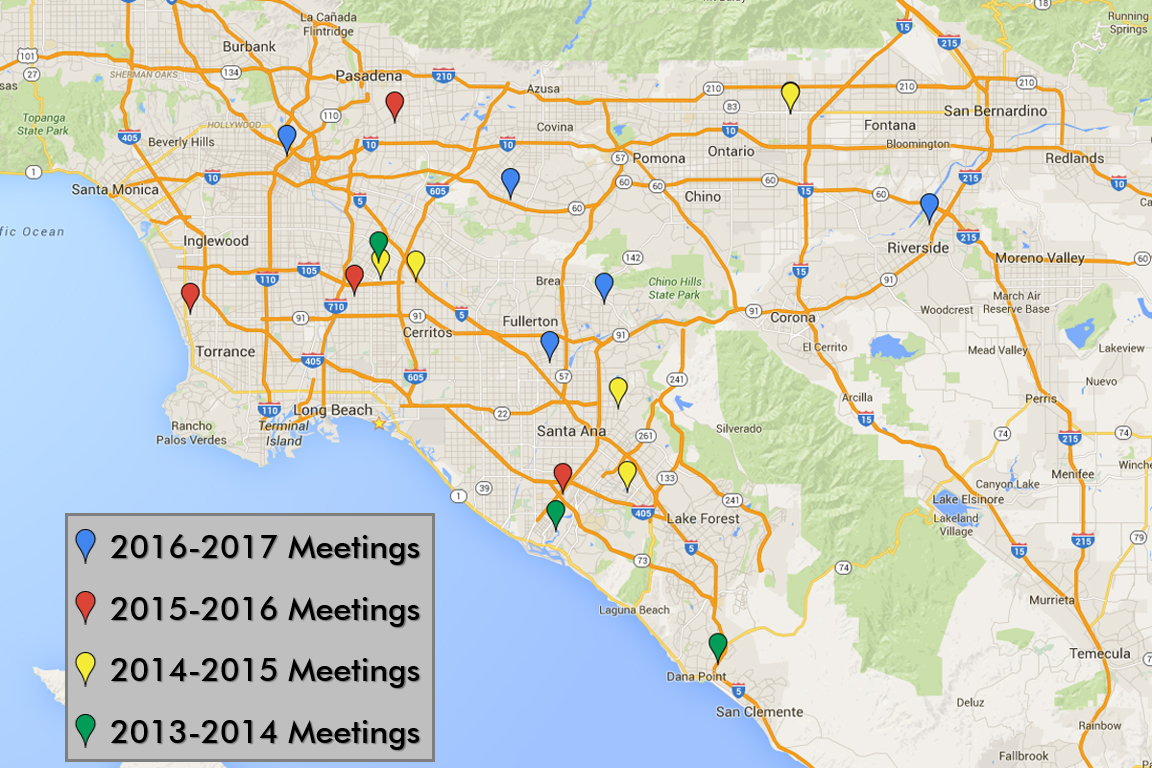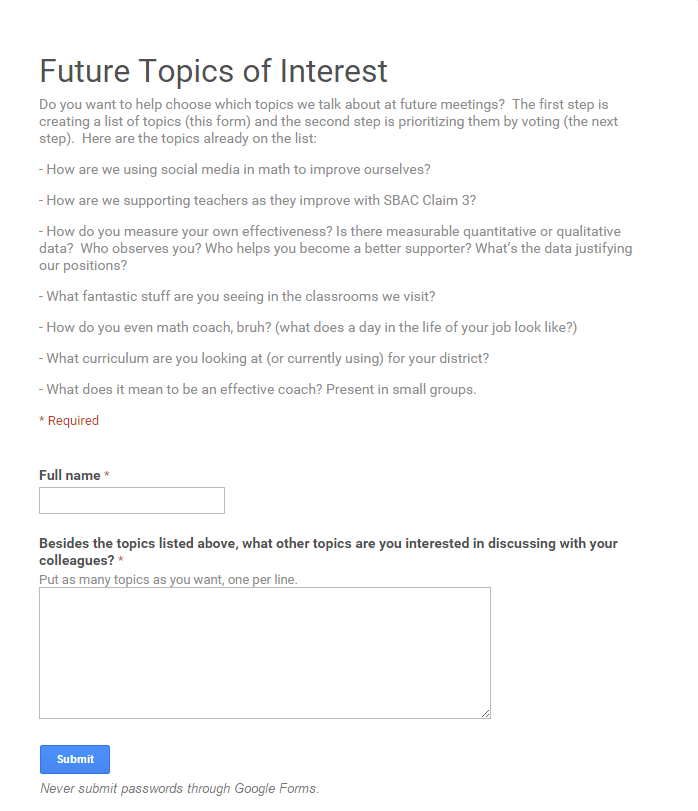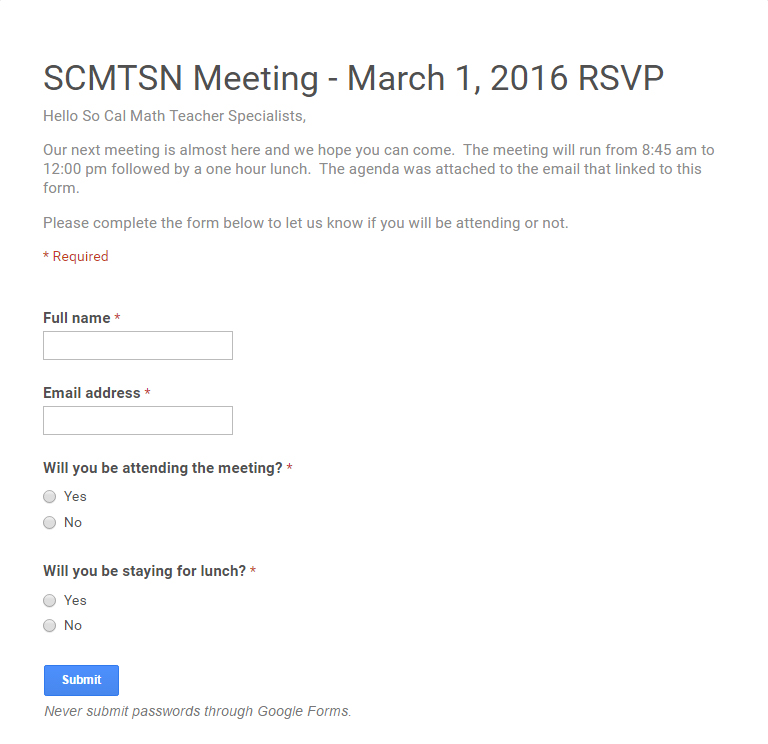This is part three of a series of six posts on how to create a mathematics teacher specialist network. Find the entire series here.
So your network is established and growing and you’re ready to start exchanging ideas with your colleagues. It’s time to set up ways to share information online and potentially in person as well. The easiest place to start is with setting up an online community. Our group uses Edmodo (which is something like a Facebook for education) but anything that allows people to share information should work. If you do choose to use Edmodo, create a group and share the “group code” with your network so that they can join your group.
With your electronic community in place, you now have a venue to share information. To give you an idea of the questions we ask one another, I’ve pasted a few recent posts from the Southern California Math Teacher Specialist Network Edmodo page below. Note that all of these questions would be either much harder or impossible to answer without having access to the other members in the network.
- Is anyone offering a Pre-Calculus summer bridge course to allow students to advance into AP Calculus their senior year?
- I need course description for ____________ please….
- Please fill out this anonymous form so we can share info on failure rates for HS math courses.
- What universal screeners are you using to help us identify which students need intervention?
Eventually you will be in a place where your network of teacher specialists will be ready to meet in person. The reality is that the idea of taking time off from your daily job duties to meet with other teacher specialists may be met with a variety of responses from bosses. On one end of the spectrum, your supervisor may be excited that you will have other people to learn from and get ideas that are already tested without spending significant time in creating them. On the other end, your supervisor may be disappointed that you think this would be a good use of your time when there is already so much for you to do that is part of your job description. Hopefully you are in the former situation, and not the latter. If the latter is the case though, consider showing your supervisor the first of this series of blog posts which talks about why this network is so important.
The Southern California Math Teacher Specialist Network has been meeting in September, November, January, March, and May since January 2014. Some math teacher specialists joined the network in the very beginning and have attended every one of our twelve meetings. Other math teacher specialists also joined the network in the very beginning but have never attended a single meeting because their administrators have other priorities for them. Most teacher specialists come to as many meetings as their schedules permit. It has been my personal experience, that the time I spend at these meetings has more than paid for itself. I continue to learn things that I would have never thought of… or if I did, my work wouldn’t have been as good.
So, realizing that not everyone will attend in person meetings, it’s best to plan for the best and see what happens. The major steps you will need to take include:
- Choosing meeting dates and locations
- Choosing topics to discuss at these meetings
- Sending out the RSVP form
My recommendation would be to follow a similar path for your group. Initially find a venue, any venue, for your meetings. As your group grows, you will clearly have more options, but what may be a central location will also change. Take a look at the image below. In 2013-2014, you will notice the meetings going farther and farther south. It didn’t feel like we had many options, but clearly the locations were less and less central. In 2014-2015, again we were excited just to have five venues to have meetings in and weren’t really thinking about locations. By 2015-2016 we had more options and tried to make a North, East, South, West, and Central location (the top yellow location also has a red pin there). What we came to realize though was that the group had shifted so far east that even our Central location was too west. So, in 2016-2017 our meetings will be much more east than in previous years.

There are a few hosting requirements we look for when choosing a venue:
- Required
- There needs to be a room large enough to hold our members. Our meetings average 30-70 people so this is not easy for every district.
- There needs to be movable tables and chairs.
- Helpful
- Snacks or lite breakfast foods and drinks – this is not required but is nice, and most of the hosts have provided this.
- WiFi – this is also not required, but if there isn’t any, we choose non-Internet based topics
- Creating a map with directions and parking info – sometimes I help with this
- Finding a place for a buffet lunch – the group always goes out to an optional buffet lunch afterwards, and it has to be buffet because there is no pracical alternative for 20+ people going out to eat
- Name tags – nice, but not required
- Digital projector – this can be useful to project a timer or share information
At each meeting we discuss two major topics. Initially the topics were picked by what a few perceived to be the hot topics of the time (Integrated vs. Traditional, textbooks, acceleration, etc.). These days the topics are chosen democratically by the entire network.
The process begins with surveying members for potential topics to talk about. It usually begins by taking place at the end of a meeting and then continues online where people can submit potential topics via a Google form. Here’s a picture of what that form looks like:

After a couple of weeks the results of those surveys are transferred to another Google form where each topic is listed with a scale so they can be prioritized. The topics with the highest scores are the ones we talk about first. Here’s a picture of what that form looks like:

- Agenda (both in text and attached as a PDF)
- Location (including the address, specific directions such as where to park or how to find the room, and a map if needed)
- Topics (from the surveys)
- Lunch (where we will be eating so people can decide if they want to come)
- RSVP form link (picture of the form below)

The purpose of having the RSVP data is to have an idea of how many people to set up for at the meeting as well as adjust lunch reservations accordingly. Next week I’ll discuss what happens during the meetings.


3 Comments